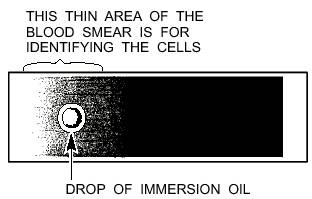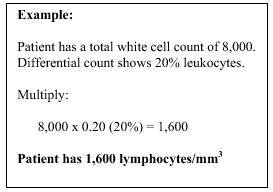|
COUNTING THE CELLS.-Once the blood
smear has been stained, it is placed under a
microscope, and the differential count is conducted.
To perform a differential white cell count, you
should follow the steps listed below:
1. Place the slide under the microscope. Switch
the oil immersion objective (red) (100X) into
position above the stage. Turn the
coarse adjustment to raise the oil
immersion objective about 1 inch above
the opening in the stage. Open the
condenser and switch on the microscope
light.
2. Place a large drop of immersion oil on the thin
area of the blood smear. See figure 7-19.
3. Hold the slide so the thin area is on your left.
Then fix the slide firmly in the jaws of
the mechanical (movable) stage. Move
the mechanical stage so the drop of oil
on the slide is directly over the
bright light coming up from the
condenser.
4. Using the coarse control knob, you should now
slowly lower oil immersion objective into the
drop of oil (on the slide). When the
objective is in the drop of oil,
continue turning the coarse adjustment
until the objective is touching the
glass slide.
5. Now, while continually looking through the
eyepiece, VERY SLOWLY rotate the coarse
adjustment toward you until you see some cells.
After you have brought the cells into view
with the coarse adjustment, bring the
cells into perfect focus by rotating
the fine adjustment. NOTE: Always
rotate the fine adjustment back and
forth when identifying cells. This step will
help you see the various layers of the cell and
thereby help you to identify the different
types of white cells.
6. Count 100 consecutive white cells, pressing the
correct key on the cell counter for each type of
white cell identified. (If the cell counter
is not available, record cell type and
number of cells encountered on a piece
of paper.) Follow path similar to one
illustrated in figure 7-20 to count
cells.
7. Total each type of white cell. If you count 20
lymphocytes among the 100 cells, the
differential count for lymphocytes is 20%.
Continue this process until your count
totals 100%. This differential count is
referred to as a relative count. Another
differential count that may be
requested is an absolute count. To
perform an absolute count, multiply the total
white cell count by the individual cell
percentages. See the example below.

Figure 7-19.-Placement of immersion oil on blood smear.


Figure 7-20.-Counting path for
differential count.
NOTE: When performing the white cell
count, you may observe abnormal white
cells such as distorted lymphocytes,
smudge cells, and disintegrated cells.
Distorted lymphocytes, which appear
squashed or distorted, are caused by
excessive pressure on the cell during the
process of making the smear. Distorted
cells should be recorded as normal
lymphocytes. Smudge cells are white
cells that have ruptured and only the
nucleus remains. Afew smudge cells may
be found in a normal blood smear.
Smudge cells should not be added to the
count or recorded. Disintegrated
cells are ruptured cells, but the
nucleus and cytoplasm still remain.
Disintegrated cells should not be
counted as one of the 100 cells, but
should be recorded on the report as
"disintegrated cells."
8. Once the differential count is completed,
proceed to step 4, reporting the count.
NOTE: If it is desirable to save a smear
for reexamination, remove the immersion
oil by placing a piece of lens tissue over
the slide and moistening the tissue
with xylene. Draw the damp tissue
across the slide, and dry the smear
with another piece of lens paper.
|

